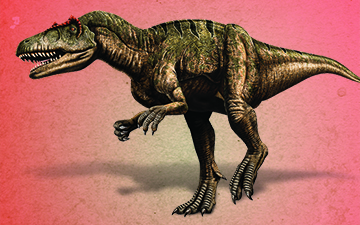Allosaurus (/ˌæləˈsɔːrəs/[1][2]) is a genus of large theropod dinosaur that lived 155 to 150 million years ago during the late Jurassic period (Kimmeridgian to early Tithonian[3]). The name “Allosaurus” means “different lizard”. It is derived from the Greek ἄλλος/allos (“different, other”) and σαῦρος/sauros (“lizard / generic reptile”). The first fossil remains that can definitely be ascribed to this genus were described in 1877 by paleontologist Othniel Charles Marsh, and it became known as Antrodemus. As one of the first well-known theropod dinosaurs, it has long attracted attention outside of paleontological circles. Indeed, it has been a top feature in several films and documentaries about prehistoric life.
Allosaurus was a large bipedal predator. Its skull was large and equipped with dozens of sharp, serrated teeth. It averaged 8.5 m (28 ft) in length, though fragmentary remains suggest it could have reached over 12 m (39 ft). Relative to the large and powerful hindlimbs, its three-fingered forelimbs were small, and the body was balanced by a long and heavily muscled tail. It is classified as an allosaurid, a type of carnosaurian theropod dinosaur. The genus has a complicated taxonomy, and includes an uncertain number of valid species, the best known of which is A. fragilis. The bulk of Allosaurus remains have come from North America‘s Morrison Formation, with material also known from Portugal and possibly Tanzania. It was known for over half of the 20th century as Antrodemus, but study of the copious remains from the Cleveland-Lloyd Dinosaur Quarry brought the name “Allosaurus” back to prominence, and established it as one of the best-known dinosaurs.
As the most abundant large predator in the Morrison Formation, Allosaurus was at the top of the food chain, probably preying on contemporaneous large herbivorous dinosaurs and perhaps even other predators. Potential prey included ornithopods, stegosaurids, and sauropods. Some paleontologists interpret Allosaurus as having had cooperative social behavior, and hunting in packs, while others believe individuals may have been aggressive toward each other, and that congregations of this genus are the result of lone individuals feeding on the same carcasses. It may have attacked large prey by ambush, using its upper jaw like a hatchet.
(From Wikipedia, February 2017)




